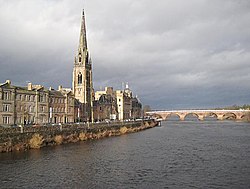 Looking north in 2025, with the County Buildings and St Matthew's Church in view | |
 | |
| Part of | A989 |
|---|---|
| Length | 0.47 mi (0.76 km) |
| Location | Perth, Perth and Kinross, Scotland |
| North end | West Bridge Street and Charlotte Street |
| Major junctions | High Street South Street Canal Street |
| South end | Marshall Place and Shore Road |
| Construction | |
| Completion | c. 1870 |
Tay Street is a street, part of the A989, in the Scottish city of Perth, Perth and Kinross. Planned in 1806 and completed around 1885, it is named for the River Tay, Scotland's longest river, on the western banks of which it sits. The street runs from the confluence of West Bridge Street and Charlotte Street in the north to a roundabout at Marshall Place and Shore Road in the south. Three of the city's four bridges that cross the Tay do so in this stretch (from north to south): Perth Bridge (also known as Smeaton's Bridge), Queen's Bridge and the single-track Tay Viaduct, carrying Perth and Dundee trains to and from Perth railway station, located 0.5 miles (0.80 km) to the north-west. [1]
Contents
Thomas Hay Marshall and his father-in-law Thomas Anderson (owner of the former Blackfriars lands), who were responsible for the construction of much of Georgian Perth, made the first steps in the creation of Tay Street in the late 18th century when they constructed Atholl Crescent and Atholl Street in the north and Marshall Place in the south. [2] The sections in between were gradually filled in over the course of the next century.
"A curving line of elegant buildings," [3] Tay Street links the city's two main parks, the North Inch and the South Inch.
Water Vennel, one of Perth's many vennels, leads between Tay Street and Watergate.













